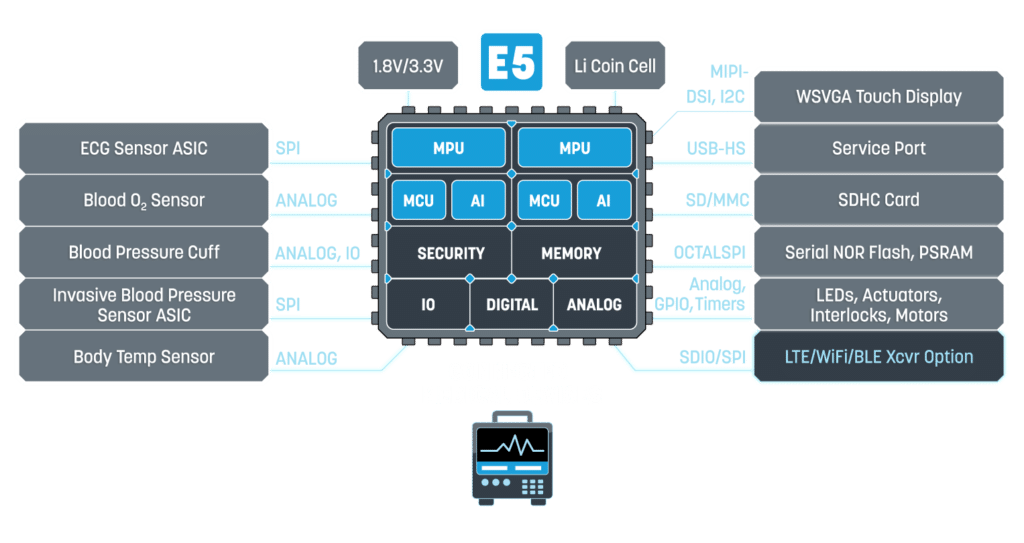AI health devices and health wearables expand the capabilities of today’s technology.

Introduction
The emergence of Artificial Intelligence & Machine Learning has transformed the landscape of health monitoring wearables and connected health devices. Let’s examine two devices from Alif Semiconductor, the Ensemble E5 and Ensemble E3, and how they support the new standard in health technology.
Artificial Intelligence for Health Monitoring Wearables
AI/ML has become a crucial component in technology for heart monitoring devices, which gives users the ability to track and analyze trends in health data, predict and reduce cardiac events, and ultimately decrease mortality by getting patients to the hospital before a cardiac event or heart failure occurs. Heart monitoring is no longer only for those who are at risk for cardiac events, but also for those who want to monitor their vital signs recreationally, such as during exercise. Wireless wearables opened a new frontier for heart monitoring devices, as options were no longer limited to implantable devices like pacemakers, which would only be used by someone at risk for a cardiac event. Now, the average healthy person can track their vitals through a multitude of wearables and mobile apps. Everyday consumers now have the ability to identify early signs of illness and seek preventive care, which ultimately reduces treatment costs and prevents deaths by getting people to a doctor before a health crisis occurs.
This level of data collection and complex analysis requires artificial intelligence. AI can be used to capture data from medical sensors, such as a fitness wearable that tracks your heart rate. This data can then be stored and analyzed for patterns, trends, or irregularities, effectively identifying or predicting disease.
However, one problem heart monitoring wearables are facing today is running constant AI/ML workloads without draining battery on wireless devices.
Alif Ensemble E5 Fusion Processor For AI Health Wearables
The Alif Ensemble E5 series is a fusion processor (a new category of embedded controllers that blend MPU, MCU, and AI/ML into a single device) which combines a Cortex-A32 application core running at up to 800MHz, and two Cortex-M55 cores, enabling you to combine real-time performance with high-level operating systems like Linux in the same package.
By utilizing a dedicated NPU accelerator for AI/ML, Alif Ensemble can run inferencing operations faster and more efficiently than any other microcontroller available. The Ethos-U55 microNPU offloads AI/ML operations from the Cortex-M55, allowing the M55 cores to operate in very low power modes, to ensure that power consumption is minimal on health wearables.
- Energy consumption of an AI workload is reduced by up to 90% when compared to other Cortex-M devices.
- Accelerated inference operations on Ensemble can run as much as 2 orders of magnitude faster than unaccelerated operations

Protecting Patient and User Data With Alif’s Secure Enclave
Protecting sensitive patient data is a primary feature of Alif Ensemble with a flexible configuration matrix that gives you granular control of exactly which part of your application can access sensitive information. Additionally, a secure 4-stage lifecycle management system makes it impossible to rollback system updates to exploit previously uncovered issues. These measures ensure the device’s integrity, safeguard identities and establishes a strong foundation of trust. System designers can securely manage all aspects of the device lifecycle, including key management, certificate management, remote updates, and more. Legacy MCUs may stop at TrustZone, but Ensemble takes you beyond TrustZone to ensure that multi-core devices are protected, by enabling and managing access to multiple security domains. This is especially important for heart monitoring devices that rely on multi-core AI/ML MCUs to track and analyze vitals and trends.
Artificial Intelligence for Hearing Assistive Technology
The current standard in hearing assistive technology also requires AI/ML integration. Amplifying surrounding sounds is only one small piece of the puzzle; hearing devices also need to be able filter out background sounds in noisy environments. Or be able to recognize voices you hear often (spouse, family, friends) and prioritize them over other voices in a public place. The Ethos-U55 microNPU allows hearing aids to mimic how users would hear sounds if they did not have a hearing impairment. Hearing devices can perform millions of calculations and inferences to analyze tone, pitch, and pattern and allow the hearing impaired to recognize words and react in the same way the human brain does, such as having a positive or negative emotional association to certain words or tones.
Continuously gathering and analyzing this much data requires a microcontroller capable of handling heavy AI/ML workloads, without draining a device’s battery life.
Alif Ensemble E3 Microcontroller for AI in Hearing Assistive Technology
The Alif Ensemble E3 series is a dual-core microcontroller, with the High-Performance Cortex-M55 MCU core running at up to 400MHz, and a second High-Efficiency Cortex-M55 MCU core that can handle the always on operations of your application with minimal power consumption. When more performance is needed, the High-Performance core wakes up fast, finishes the job quickly and goes back to sleep, allowing hearing devices to run for years between battery replacements. Both MCU cores can be paired with Ethos-U55 microNPU’s to further maximize the real-time processing capability of the design.
Alif Ensemble E3 can support even further advancements in hearing aid technology by running additional AI/ML operations that track physical movement, detect falls, and monitor vitals. Hearing devices can then connect to your phone wirelessly to transmit this data and carry out activities like notifying emergency services if a fall is detected.
Conclusion
With the rapid advancement in the requirements for health monitoring devices, it is necessary to rely on a microcontroller that can handle demanding AI/ML workloads while maintaining a tiny package size, without compromising on battery life. Alif Ensemble effectively fills this gap and simplifies the solution further by packaging all needed components into a single chip solution, including up to 19 MB of integrated memory, an isolated security subsystem, analog & digital peripherals, PMIC, and more.